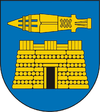Zgorzelec
Zgorzelec (pronounced Zgo-zhe-letz [zɡɔˈʐɛlɛt͡s] (![]()
Zgorzelec | |
|---|---|
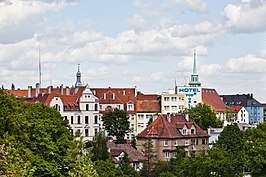  
| |
 Flag 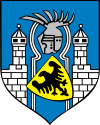 Coat of arms | |
 Zgorzelec 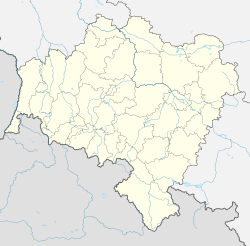 Zgorzelec | |
| Coordinates: 51°09′00″N 15°00′30″E | |
| Country | |
| Voivodeship | |
| County | Zgorzelec County |
| Gmina | Zgorzelec (urban gmina) |
| Government | |
| • Mayor | Rafał Gronicz |
| Area | |
| • Total | 15.88 km2 (6.13 sq mi) |
| Population (2019-06-30[1]) | |
| • Total | 30,374 |
| • Density | 1,900/km2 (5,000/sq mi) |
| Time zone | UTC+1 (CET) |
| • Summer (DST) | UTC+2 (CEST) |
| Postal code | 59–900 to 59–903 |
| Car plates | DZG |
| Climate | Cfb |
| Website | zgorzelec |
History
Up until 1945, the modern-day towns of Zgorzelec and Görlitz were a single entity; their history up to that point is shared. The date of the town's foundation is unknown.[2]
Middle Ages to 19th C
Zgorzelec/Görlitz was first mentioned in a document from the King of Germany, and later Holy Roman Emperor, Henry IV in 1071 as a small Sorbian village named Goreliz in the region of Upper Lusatia.[2] Since 965, the village was part of the Margraviate of Meissen, a frontier march of the Holy Roman Empire. It was conquered by Polish Duke, and future King, Bolesław I the Brave in 1002, and remained part of Poland during the reign of the first Polish kings Bolesław I the Brave and Mieszko II Lambert until 1031, when the region fell again to the Margraviate of Meissen. In 1075, the region came under the rule of the Duchy of Bohemia. In the 13th century the village gradually turned into a town. It became rich due to its location on the Via Regia, an ancient and medieval trade road. In 1319 it became part of the Piast-ruled Duchy of Jawor, and later on, became part of Bohemia again.
In the following centuries, from 1346, it was a wealthy member of the Six-City League of Upper Lusatia, consisting of the six Lusatian cities Bautzen, Görlitz, Kamenz, Lauban, Löbau and Zittau. The town of Gorlice in southern Poland was founded during the reign of Casimir the Great in 1354 by ethnic German colonists from Görlitz, in the last phases of eastward settlement by Germans (in this case by Walddeutsche).
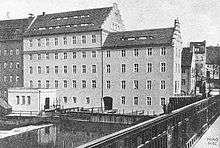
In the 15th century, the city came under Hungarian rule, but eventually returned to Bohemia. After suffering for years in the Thirty Years' War, the region of Upper Lusatia (including Görlitz) passed to Saxony (1635), whose Electors were also Kings of Poland from 1697. One of the two main routes connecting Warsaw and Dresden ran through the city at that time.[3]
In 1815, after the Napoleonic Wars, the Congress of Vienna awarded Görlitz to the Kingdom of Prussia and subsequently the city became part of the German Empire in 1871. The city was a part of the Prussian province of Silesia from 1815 to 1919.
20th century
After the abolition of the Kingdom of Prussia in the aftermath of World War I, Görlitz became a part of the newly established Province of Lower Silesia in the Free State of Prussia.
During World War II a German prisoner-of-war camp, Stalag VIII-A was located in present-day territory of Zgorzelec. The French composer Olivier Messiaen was one of its inmates.[4][5]
The Treaty of Zgorzelec, between Poland and East Germany, was signed in the city's community center in 1950. The establishment of the Oder-Neisse line as the Polish-East German border divided Görlitz (lying on the Neisse) between the two countries. The German part retained the name Görlitz, while the Polish part became Zgorzelec. The German and Sorbian population was expelled from Zgorzelec. New Polish and Greek settlers arrived in the town.

Starting in 1948, some 10,000 Greek Refugees of the Greek Civil War, mainly communist partisans, were allowed into Poland and settled mainly in Zgorzelec. There were Greek schools, a Greek retirement home and even a factory reserved for Greek employees. The majority of those refugees later returned to Greece, but a part remains to this day (see Greeks in Poland). The Greek community of Zgorzelec was instrumental in the building of The Orthodox church of Ss Constantine and Helen in 2002. Since 1999, an annual international Greek Song Festival has been held in Zgorzelec.[6]
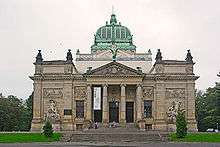
Recent history
Since the fall of communism in 1989, Zgorzelec and Görlitz have developed a close political relationship. Two of the numerous bridges over the Neisse river that had been blown up by retreating German forces in World War II have been rebuilt, reconnecting the two towns with one bus line. There is also common urban management and annual common sessions of both town councils. In 2006 the towns jointly applied to be the European Capital of Culture in 2010. It was hoped that the jury would be convinced by the concept of Polish-German cooperation, but the award fell to Essen, with Görlitz/Zgorzelec in second place.
Sights
- Miejski Dom Kultury (Municipal House of Culture)
- Polish-Saxon post milestone of King Augustus II of Poland and the reconstructed Postal Square (Plac Pocztowy)
- Military cemetery of the Polish Second Army – one of the largest military cemeteries in Poland
- Historical parks
- Greek Boulevard (Bulwar Grecki), with a view of Görlitz
- Wheelwright Croft (Zagroda Kołodzieja)
- Old townhouses in the city center
- Former Tricycle Mill (Młyn trójkołowy)
- Baroque palace in Zgorzelec-Ujazd
Transport
Zgorzelec is served by two railway stations, Zgorzelec in the southern part of the town, and Zgorzelec Miasto in the eastern part.
Sports
Turów Zgorzelec men's basketball team until 2018 played in the Polish Basketball League (top division). In 2014 Turów won its only national championship and qualified to the Euroleague for the first time.
Notable residents
- Jakob Böhme (1575–1624), German theologian
- Grzegorz Żmija (born 1971), goalkeeper
- Agata Korc (born 1986), Polish swimmer
- Honorata Skarbek (born 1992), Polish singer
Twin towns – sister cities
Gallery
 Aerial view of Zgorzelec
Aerial view of Zgorzelec- Warszawska Street
- Wheelwright Croft
 Amphitheatre of Zgorzelec
Amphitheatre of Zgorzelec Bridge between Zgorzelec and Görlitz
Bridge between Zgorzelec and Görlitz Saint Joseph church
Saint Joseph church Andrzej Błachaniec Park
Andrzej Błachaniec Park.jpg) Park Ujazdowski
Park Ujazdowski- Greek Boulevard (Bulwar Grecki)
- Townhouses at Piłsudskiego Street
 Okrzei Street (Ulica Okrzei)
Okrzei Street (Ulica Okrzei).jpg) Border signboard
Border signboard
References
- "Population. Size and structure and vital statistics in Poland by territorial divison in 2019. As of 30th June". stat.gov.pl. Statistics Poland. 15 October 2019. Retrieved 14 February 2020.
- "History of Zgorzelec and Görlitz". Retrieved 30 December 2016.
- "Informacja historyczna, Dresden-Warszawa". Retrieved 1 June 2019.
- "European Center Memory, Education, Culture". Meetingpoint Music Messiaen e.V. 17 April 2020. Retrieved 27 May 2020.
- "Stalag VIII A". Meetingpoint Music Messiaen e.V. 2 May 2019. Retrieved 27 May 2020.
- "Ambasada Grecji w Warszawie – Grecy w Polsce". www.greece.pl. Archived from the original on 2 March 2003. Retrieved 9 June 2009.
- "Miasta Partnerskie". zgorzelec.eu (in Polish). Zgorzelec. Retrieved 4 March 2020.
External links
| Wikimedia Commons has media related to Zgorzelec. |
- Zgorzelice in the Geographical Dictionary of the Kingdom of Poland (1895) (in Polish)
- Official Municipal Portal (in Polish/English/French/German/Greek/Ukrainian)
- Tourist Information (in Polish, English, and German)
- Civic Portal (in Polish)
- Urban Portal (in Polish)
- Görlitz Internet Portal (in German, English, and Polish)
- The Old Town Bridge (online camera)
- "Görlitz/Zgorzelec – Urban development from 12th to 21st century" on YouTube

